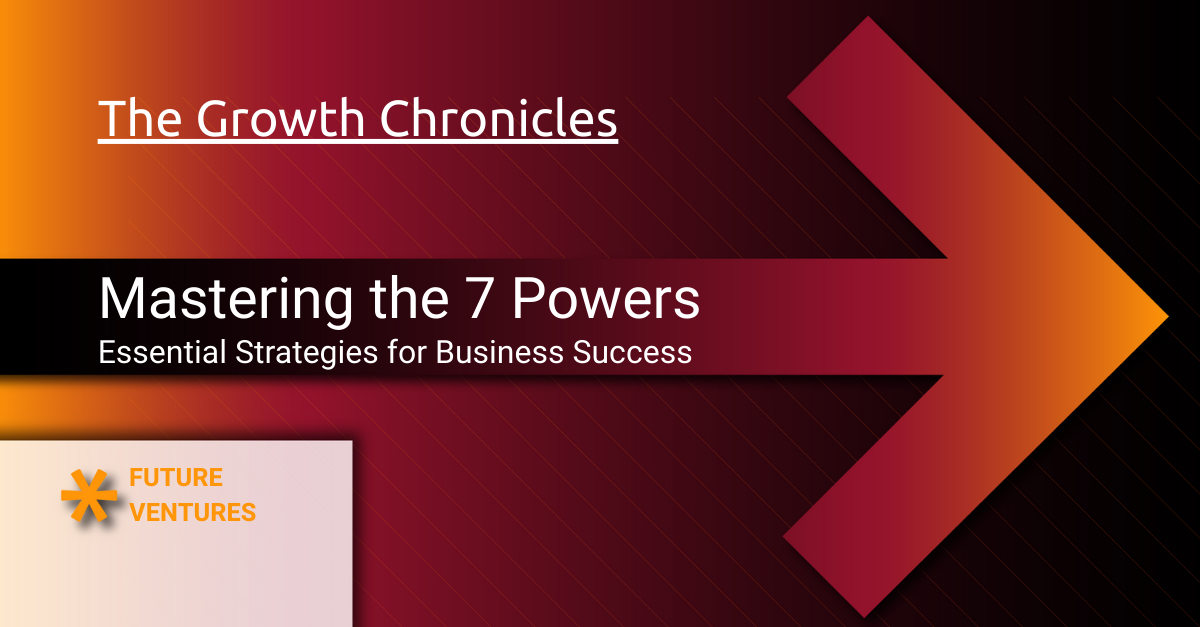Crafting a Winning Agentic AI Business Strategy for Future Success
Future Ventures Corp. | Scale-Up Advisory Series | 2025 Edition
Agentic AI is rapidly transforming operational efficiency. Its transformative potential extends beyond automation, offering organizations the opportunity to reshape business strategy and gain a competitive edge.
By automating routine processes, agentic AI reduces manual workloads, enabling teams to focus on higher-value tasks. Achieving tangible benefits early in agentic AI initiatives is crucial to demonstrating value, building momentum, and securing ongoing investment.
Executive Summary
You already know that artificial intelligence (AI) has radically transformed marketing, sales, and supply chains, driving sustainability and resilience globally. But what you may not appreciate is that you’re not simply dealing with an incremental upgrade. You are standing at a strategic inflection point. The leap is from tool-based AI (automate this, predict that) to agentic AI: systems that don’t just respond or generate, they act, decide, learn, and collaborate with you. Companies that embrace agentic AI now will gain a competitive edge in productivity and innovation through autonomous decision-making.
In this whitepaper, you’re going to learn how to treat this not as a technology project but as a Scale-Up Imperative: a structural transformation that aligns with your Enterprise Value Map (EVM), leverages your Founder Leverage Model, and demands a fresh Operational Leverage Stack. It’s about turning agentic AI into a core part of how you create enterprise value, not just cost savings. Implementing agentic AI necessitates redesigning enterprise platforms for enhanced interoperability and improved performance.
More specifically, we'll walk through:
- The foundational shift from reactive to agentic AI.
- Why this matters for scaling companies (and why many will fail).
- How to embed agentic AI into your operating system using our D4 Framework: Data → Decision → Delegation → Differentiation.
- A CEO playbook (the 5-step roadmap).
- The major barriers and how to overcome them (with Governance Guardrails and Strategic Response Framework in play).
- And finally, a futurist lens: what’s coming next, how you win.
Because agentic AI can accelerate business processes by 30% to 50%, it can transform operational efficiency. Deploying agentic AI delivers significant efficiency gains, streamlining workflows and generating additional value across business operations. Agentic AI can also reduce human error and cut low-value work time by 25% to 40%, enabling teams to focus on higher-value tasks.
If you’re a founder, CEO or business owner and you treat this as a mere “AI project”, you’ll lose. If you treat this as a business model transformation, you’ll dominate.
1. The Foundation: The Agentic Shift
In the late 1990s, businesses still used GPS units. By the mid-2010s, they used smartphone maps. Now we’re shifting into the autopilot era where the system drives, you monitor. That’s the analogy for the move from traditional AI to agentic AI.
An AI agent is an autonomous software component capable of performing tasks, making decisions, and coordinating across multiple systems within an organization.
Agentic AI systems are designed to handle complex and adaptive decision-making processes, including real-time decision-making, by leveraging advances in deep learning, generative AI, and autonomous systems.
1.1 What is Agentic AI?
- Traditional AI: prediction and classification. You prompt, it outputs.
- Generative AI: the creator. It generates text, images, and code, but you still decide what to do with it.
- Agentic AI: the orchestrator. It sets goals, executes tasks, adapts and learns.
Definition: Agentic AI refers to AI systems designed to autonomously make decisions and act, with the ability to pursue complex goals with minimal supervision. “It’s an ability to handle really complex and adaptive decision-making processes without human guidance.”
| Era | Type | Core Function | Human Role | Strategic Outcome |
|---|---|---|---|---|
| 2010s | Traditional AI | Pattern recognition | Oversight | Automation |
| 2020s | Generative AI | Content/idea generation | Collaboration | Creativity & efficiency |
| 2025+ | Agentic AI | Autonomous decision/action | Orchestration & strategy | Strategic leverage & scalability |
Agentic AI represents a fundamental shift from passive AI to systems that pursue complex goals, adapt, and collaborate with humans and other agents. The potential of agentic AI is significant, enabling artificial intelligence systems to act independently, make decisions, and continuously learn through continuous learning. Recent breakthroughs in AI allow for reductions in human error by enhancing workflows by 30% to 50%, making them indispensable for modern enterprises.
Agentic AI enables autonomous decision-making and real-time optimization without constant human input. Agentic AI systems act autonomously, initiating tasks, adapting in real time, and learning from past interactions through continuous learning. These systems can manage complex workflows by reasoning, planning, and adapting across multiple platforms and tasks, automating processes that were once considered too challenging for full autonomy. Unlike traditional AI, agentic AI proactively reasons, acts, and learns to enhance efficiency and scalability. AI agents operate 24/7 and can handle data traffic spikes without requiring additional headcount, thereby boosting productivity and business value.
⚡Key Insight: The shift isn’t incremental; it’s structural. And if your thinking remains tool-first, you’ll lag behind.
1.2 High-impact areas for agentic AI
High-impact areas for agentic AI include tasks that are repetitive, time-consuming, or data-rich, where automation provides immediate value and visible ROI. While simple task automation handles standardized, repetitive work, agentic AI takes it a step further by enabling proactive, autonomous, and adaptive workflows that transform overall operations.
Agentic AI enhances service levels and reduces logistics costs in supply chain operations, contributing to increased enterprise value. In marketing and sales, autonomous agents optimize campaigns and personalize engagement, significantly boosting lead conversion and revenue.
These capabilities enable organizations to shift their focus from routine tasks to strategic, high-value initiatives, unlocking new revenue streams and enhancing operational efficiency. By embedding agentic AI into core business processes, companies can achieve measurable returns and gain a competitive edge in productivity and responsiveness.
1.3 Why this matters for you as a scaling Founder/CEO
- You’re in the Scale-Up Imperative phase: you’ve built product-market fit, now you’re scaling operations, teams, and systems. Agentic AI gives you the leverage you haven’t yet captured.
- Through your Enterprise Value Map, you track six levers: Growth, Margin, Talent, Risk, Innovation and Impact. Agentic AI touches all of them.
- If you leave it in the “IT project” bucket, you’re mistaking the symptom for the strategy.
2. The Scale-Up Imperative
You and your peers have built something real. The next phase isn’t just more of the same; it’s about structural leverage. Agentic AI is your chance to re-architect your business model. As intelligent automation evolves, it is giving rise to self-optimizing, adaptive agentic AI systems that can proactively manage complex workflows and drive autonomous, strategic automation beyond traditional tasks.
2.1 Reframing your mindset
Think of it this way: In the past, you were an AI tool user. Now you must become an AI system architect. You don’t ask “which model do I use?” You ask, “How do I embed autonomous agents into my business operating system so they deliver to my Enterprise Value Map?” Embedding agents into core enterprise platforms, such as CRM and ERP systems, is crucial for enabling seamless, agent-led workflows and decision-making that go beyond simple API interactions.
The stakes are:
- Agentic AI can reduce human error and cut low-value work by 25-40% in some processes.
- The market is already pricing in the winners of this next wave.
- Many firms will fail this transition
⚡Key Stat: Gartner estimates > 40% of agentic AI projects will be scrapped by end-2027 due to unclear business value.
2.2 The Role of AI Systems in Business
AI systems, including agentic AI, are revolutionizing business practices and opening up new avenues for growth. Autonomous AI agents streamline complex workflows across various systems, amplifying the effectiveness of vertical-specific applications. Tools like Large Language Models (LLMs) improve operational efficiency and customer relationship management. Agentic AI enables companies to move from routine tasks toward strategic, high-value projects.
2.3 Business Operations and AI Transformation
AI transformation represents a strategic turning point that demands large-scale, company-wide efforts driven by CEOs. Business operations are evolving with agentic AI, which empowers autonomous decision-making and real-time optimization. AI automation helps boost operational efficiency, cut costs, and enhance customer experience. Implementing agentic AI requires a core change in business processes, enabling teams to focus on high-value activities.
2.4 Generative AI and Business Applications
Generative AI is employed in diverse business areas such as content creation and data analysis. Building on this, agentic AI introduces autonomous decision-making and real-time optimization. While generative AI has proven valuable in marketing, sales, and supply chain management worldwide, agentic AI signifies a significant evolution. Investments in generative AI are expected to increase, with the agentic AI market forecasted to hit US$45 billion by 2030.
2.5 The Importance of Data Quality in AI
High-quality data is crucial for successful AI deployments, including agentic AI. Effective data governance ensures the accuracy and reliability of AI systems. Data engineers are vital in creating and integrating AI solutions into existing legacy systems, ensuring that high-quality data is available and usable for AI and machine learning. Since AI systems depend on large data volumes to learn and enhance their performance, data quality is essential for AI success. Enterprise data feeds into training AI models, enabling autonomous decision-making and real-time optimization.
Aligning to your Enterprise Value Map (EVM)
Each lever of your EVM demands a purpose for agentic AI:
- Growth: New business models where agents deliver services or products.
- Margin: Shifting cost base to autonomous systems.
- Talent: Deploying your people on higher-order tasks while agents handle the operational layer.
- Risk: Agents with continuous monitoring and early-warning systems.
- Innovation: Experimentation with multiple agents for new revenue streams.
- Impact: Ethical agentic systems that enhance stakeholder trust and brand.
If you build agentic AI in isolation from these value levers, you’ll get a shiny pilot, not a value-creating platform.
3. Designing Your Agentic Operating System
Let’s move from concept to architecture. At Future Ventures, we refer to this as the D4 Model: Data → Decision → Delegation → Differentiation. AI agents provide real-time insights from vast amounts of data, enhancing strategic decision-making for product launches or market entry. A flexible, modular, cloud-native architecture is crucial for building a scalable infrastructure that supports the computational demands of AI systems, ensuring seamless integration and optimal performance. AI agents must also be integrated with legacy technologies through smart solutions that bridge modern and old systems, ensuring interoperability across the enterprise.
Step 1: Data
You need high-quality, context-rich, integrated data. Agents don’t just analyze; they act. They need real-time inputs, accessible pipelines, semantic layers, and interoperable systems. Without this foundation, you’ll get “agentic experiments”, not agentic platforms.
Step 2: Decision
Agents must be able to decide. That means embedding decision logic, rules, business context, and feedback loops. Not just predictions. Real-time optimization, scenario modelling, adaptive learning. That’s how you build decision velocity. Human-in-the-loop design incorporates human intervention points for high-stakes decisions, building trust and ensuring accountability, thereby ensuring that critical decisions are made with oversight and precision. Human oversight is essential throughout all phases of AI integration to manage and govern AI systems, thereby helping to ensure the safe and ethical deployment of AI.
Step 3: Delegation
Here, the magic happens: you delegate entire workflows to agents (not just small tasks). You shift from human-in-the-loop to human-on-the-loop. Agents plan, act, monitor, and escalate. Example: an insurance claims agent assesses the claim, routes it to an adjuster if needed, and triggers payment if not. Agentic AI can reduce manual workloads in processes by up to 60%.
Step 4: Differentiation
Now you build the moat. Because many will start automating, but fewer will build an agentic advantage. You embed domain-specific agents, integrate with your IP, orchestrate multi-agent systems, and align to strategic differentiation. That’s how you move from “doing operations faster” to “competing at a new level”.
The Agentic Operating Stack: from Human-in-the-Loop to Fully Autonomous
Layer by layer:
- Layer 1: Process Automation – Scripted workflows, Robotic Process Automation (RPA).
- Layer 2: Decision Support – Generative AI and Assistants.
- Layer 3: Agentic Autonomy – Agents that act under objectives.
- Layer 4: Agentic Network – Multi-agent ecosystems across functions.
⚡Key Insight: Use this stack to map where you are and where you need to go.
4. From Insight to Enterprise Value: EVM Alignment
You don’t transform for fun. You transform for value. Here’s the Operational Leverage Stack (a Future Ventures trademark) that links agentic AI to I-R-R-V (Input → Resource → Return → Value) loops.
4.1 Operational Leverage Stack
- Process Efficiency – Automating tasks reduces costs.
- Decision Velocity – Faster, better decisions increase throughput.
- Customer Intimacy – Personalized, proactive service boosts retention and Net Promoter scores.
- Capital Efficiency – Smarter use of human, technology and financial capital improves ROI.
When you stack these, you create a multiplier effect: faster decisions + better data + agentic orchestration = exponential value, not linear.
4.2 Example: Scaling Company Use-Case
Let’s say you’re a SaaS business scaling global operations.
- Stage: You’ve built product-market fit, hardware infrastructure, and a solid platform.
- Challenge: Growth is hitting bottlenecks, with support, onboarding, churn, and costs escalating.
- Agentic AI Play: Deploy support agents that triage, resolve, and escalate intelligently; onboarding agents that monitor usage patterns and recommend next steps proactively; business-intelligence agents that watch churn patterns and trigger interventions.
- Value: You might shift the support cost from $30 per case to $10 per case, reduce churn by 20%, and free up human talent to focus on upselling and strategic tasks. That changes margin, growth and talent levers on your Enterprise Value Map.
⚡Key Insight: If you map this to your EVM, you’ll see: Growth up, Margin up, Talent redeployed, Risk down. That’s how you earn strategic value, not just operational savings.
5. Building a Winning Business Strategy with AI
A winning business strategy with agentic AI requires a clear understanding of its transformative potential and a structured approach to implementation. Business leaders must strategically deploy agentic AI to unlock measurable enterprise value and secure a competitive advantage, while ensuring that human expertise and agency remain central to critical decision-making.
To build out a winning agentic AI business strategy, follow these essential steps:
- Understand Agentic AI’s Capabilities
Grasp how agentic AI systems autonomously act, learn, and collaborate to drive operational efficiency and innovation beyond traditional AI tools. - Align AI Initiatives with Business Goals
Map agentic AI opportunities directly to your enterprise value levers (e.g. growth, margin, talent, risk, innovation, and impact) to ensure every deployment supports strategic objectives. - Establish Robust Governance and Oversight
Implement governance frameworks that strike a balance between AI autonomy and human oversight, addressing key ethical considerations, risk management, and accountability to foster trust both internally and externally. - Ensure High-Quality Data and Integration
Invest in data governance and infrastructure to provide clean, accessible, and interoperable data streams that AI agents require for effective decision-making and real-time optimization. - Pilot Focused Use Cases with Measurable Outcomes
Start with targeted, high-impact workflows where agentic AI can deliver tangible benefits quickly, using clear metrics to track performance and build momentum. - Scale Through Cross-Functional Integration
Expand successful pilots horizontally and vertically, integrating agents across multiple systems and business functions to unlock broader value. - Invest in Talent and Cultural Change
Prepare your workforce by upskilling and reskilling employees to collaborate effectively with AI agents, shifting roles from task execution to strategic supervision and orchestration. - Continuously Monitor, Learn, and Adapt
Maintain ongoing performance tracking, feedback loops, and iterative improvements to optimize AI agent behavior and ensure alignment with evolving business needs.
By following these steps, organizations can unlock the full potential of agentic AI to generate new revenue streams, enhance operational efficiency, and establish a sustainable competitive edge that drives long-term business growth.
6. The Founder/CEO Playbook for Agentic Integration
Implementing AI solutions in business requires a fundamental shift in business processes and operations. Agentic AI necessitates a new operating model that enables autonomous decision-making and real-time optimization. AI deployments require careful planning, including data governance and control mechanisms. Vice presidents and other leaders must be focused on AI initiatives, driving business outcomes and creating improvements.
6.1 Strategic Response Framework for Agentic AI
Here’s the five-step roadmap you, the CEO/Founder/Owner, must own.
| Step | Key Actions & Details | Notes & Insights |
|---|---|---|
| 1. Vision Alignment | Define how agentic AI maps to your Enterprise Value Map. / Set specific goals for each value lever (e.g., “By Q4 2027, agents will handle 60% of onboarding workflows and reduce cost by 30%.”) / Communicate clearly: “We are not buying another tool. We are shifting our operating system.” | |
| 2. Governance Architecture | Establish Governance Guardrails covering data ethics, risk management, oversight, and audits. / Define ownership roles: data owner, model owner, business owner, operations owner. / Create a board-level AI Council to report on value, risk, and scale / Remember, governance and oversight are not just technical requirements but essential for public trust. | |
| 3. Data Foundation | Audit the data estate: sources, quality, integration, latency. / Define semantic layers and pipelines to provide agents with trusted, clean data. / Ensure interoperability across CRM, ERP, external APIs, and logs. | |
| 4. Pilot to Scale | Start with micro-agents focused on a single use case that delivers measurable value. Define rigorous metrics such as unit cost, time saved, and error reduction. / Scale horizontally and vertically by replicating across functions and integrating workflows. | |
| 5. Human Leverage | Redeploy talent so people shift from “doing work” to “designing work.” / Upskill and reskill employees to work alongside agents as supervisors, refiners, and orchestrators. / Foster a cultural shift embracing “augmented human + agentic system” as the new normal. |
Investing in training programs for AI literacy and collaboration skills is crucial for talent development in organizations that utilize agentic AI.
6.2 Timeline Suggestion
- 0-6 months: Vision & governance setup, data audit.
- 6-18 months: Pilot rollout, metric tracking, early wins.
- 18-36 months: Scale, multi-agent orchestration, business model transformation.
⚡Key Insight: IBM estimates many enterprises won’t realize the full benefit until 18-24 months. Continuous monitoring and logging of AI actions using key performance indicators (KPIs) is necessary to track performance and mitigate risks throughout these phases.
7. Overcoming Adoption Friction
Many companies will fail. But why?
Because they treat this like last decade’s “digitize the back-office” project. They ignore the structural nature of the shift. Leaders focused on AI adoption must address organizational complexity, external tools, and user behaviour. Governance frameworks are critical to ensuring the safe and effective deployment of agentic AI. The shift to agentic AI introduces new risks of workforce disruption, including job loss and changes to employee roles, making it essential to manage these transitions carefully. Firms should embed governance in AI systems from the outset, rather than treating it as an afterthought, to ensure accountability and long-term success.
Here are the major obstacles and how you beat them.
| Symptom | Why it happens | Strategic Fix |
|---|---|---|
| Data silos & low-quality data | Operating legacy systems, inconsistent governance | Establish a semantic layer, enforce data governance |
| Pilot-itis (many pilots, no scale) | Lack of value-map linkage | Tie every use-case to EVM levers and operational metrics |
| Governance is disconnected from the board | Lack of oversight, risk bias | Board-level AI Council + clear guardrails |
| Culture still tool-based | People see agents as “more IT” | Shift narrative: “agents are teammates” + build change plan |
| Overhyped vendor solutions (“agent-washing”) | Marketing spin, under-delivers | Build evaluation criteria: autonomy, decision-making, learning |
⚡Key Insight: The biggest blocker isn’t the tech; it’s your org chart. If you still have a “VP Automation” who reports to IT, you’re mis-architecting. Agentic AI needs a C-suite orchestration role.
7.1 Real-world cautionary tale
A global enterprise launched an agentic customer service system. They focused on technology, got a flashy pilot, but couldn’t scale: data quality was low, human roles were unclear, and governance was absent. After two years, they scrapped it. Gartner estimates that more than 40% of agentic AI projects will fail by 2027 because of unclear value and hype. Lack of visibility into AI decision-making processes is a significant implementation barrier for many organizations.
Your path needs discipline, not glamour.
8. Future Ventures’ View from 2030
Time to look through the binoculars. Here’s what the next five years will bring and how you position now to lead.
8.1 Multi-Agent Ecosystems
Individual agents will give way to agentic networks, characterized by cross-functional collaboration and autonomous workflows that span sales, operations, finance, and HR. These networks will become part of your business fabric. Companies can develop unique agentic architectures and proprietary world models that create sustainable competitive advantages.
8.2 “AI Boards” & Digital Governance Twins
Boards will request “agentic oversight”: digital twins that monitor the enterprise, run scenario simulations, and highlight risks in real-time. You’ll have to embed agentic systems into governance: not after, but before.
8.3 Valuation Multiples & Founder Leverage
Companies that build agentic moats will trade at higher multiples. Why? Because your founder leverage is amplified: you leverage not just people+process+technology, but people+process+agents. Your Founder Leverage Model becomes exponential.
8.4 Shift in Talent Economy
Agents will handle routine knowledge work. Human talent will shift up the value chain. The battle for top strategic thinkers and human-agent symphonists will intensify.
8.5 Strategic Imperative
Agentic AI is not “what’s next”; it’s the next. If you treat it like a “nice-to-have”, you’ll be disrupted by someone who treats it like the operating system.
The Agentic Advantage Matrix
| Maturity Stage | Description | Strategic Focus | EVM Impact |
|---|---|---|---|
| Stage 1: Automation | Task-based scripts & RPA | Efficiency | Cost savings |
| Stage 2: Augmentation | AI copilots & assistants | Productivity | Margin lift |
| Stage 3: Autonomy | Full agentic systems | Innovation & new models | Growth multiple |
| Stage 4: Agency Network | Agents collaborating across functions | Strategic orchestration | Enterprise leverage |
9. Key Takeaways & Next Steps
You’ve got the map. Now act. Here are your board-friendly summary points:
- Agentic AI ≠ tool upgrade: it’s a business model shift.
- Align every agentic initiative to your Enterprise Value Map.
- Build Your Operational Leverage Stack: Efficiency → Velocity → Intimacy → Capital.
- Use the D4 Model: Data → Decision → Delegation → Differentiation.
- Follow the 5-step CEO Playbook: Vision → Governance → Data → Pilot → Human Leverage.
- Apply your Governance Guardrails and embed oversight at the Board level.
- Accept that you’re entering a fall-out zone: many will fail, but winners will dominate.
- Prepare for the future: agentic networks, digital governance twins, and exponential growth in founder leverage.
Next-move checklist for your boardroom this quarter
- Conduct an “agentic readiness” assessment: data quality, ownership, workflow candidates.
- Map 3 high-impact workflows for agentic conversion in the next 12 months.
- Appoint or elevate an executive with the mandate to deploy agent-based systems, reporting directly to the CEO/COO.
- Define metrics aligned with EVM: decision velocity increase, human cost reduction, and new revenue generated.
- Organize a pilot-to-scale milestone plan for the next 18-24 months.
You are not piloting widgets here; you’re architecting the next generation of your company. The companies that figure out how to delegate best will win hardest.
About Future Ventures Corp.
Future Ventures Corp. is a strategic advisory firm specializing in scale-up companies. We advise founders, CEOs and executive teams on how to build high-leverage operating models, harness emerging technology and align growth execution with enterprise value creation. Our frameworks, including the Enterprise Value Map, Founder Leverage Model, Operational Leverage Stack and Strategic Response Framework, have been applied across dozens of tech, industrial and services scale-ups.
About the Author
Maxim Atanassov is a Partner at Future Ventures Corp., responsible for the AI and digital transformation practice. With over 25 years of advising high-growth businesses, he helps executive teams translate technology inflection points into strategic advantage. Maxim has been featured in multiple leadership forums discussing AI and enterprise-scale up strategies.
Thank you for reading. Let’s build the agentic future together!










